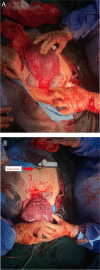Uterine torsion complicated by severe placental abruption in the second trimester: a case report and literature review
- PMID: 36681791
- PMCID: PMC9863092
- DOI: 10.1186/s12884-023-05377-z
Uterine torsion complicated by severe placental abruption in the second trimester: a case report and literature review
Abstract
Background: Uterine torsion is a rare obstetric event that can occur during pregnancy and is difficult to diagnose. Its occurrence may lead to serious adverse pregnancy outcomes.
Case introduction: The patient was a 33-year-old woman at 30+ 5 weeks' gestation with a singleton pregnancy. The pregnancy course, including fetal growth, and prenatal examinations were regular. Except for a small amount of vaginal bleeding in early pregnancy and treatment with progesterone, there were no prenatal abnormalities, and the patient denied any trauma or sexual history. The patient was admitted to the emergency department with persistent severe pain in the lower abdomen and slight vaginal bleeding during night sleep. Abdominal pain started two hours prior to admission and was accompanied by nausea, vomiting, and dizziness. Examination revealed positive abdominal tenderness, high uterine tone, and no significant intermittent period of uterine contractions, and measurement of the fetal heart rate by means of the nonstress test revealed a rate of 60 beats per minute. Therefore, placental abruption was highly suspected. Subsequently, an emergency cesarean section was performed under general anesthesia. The newborn boy, with Apgar scores of 0-3-4 after birth and weighing 1880 g, was transferred to the neonatal intensive care unit (NICU) and died two days later due to ineffective rescue. After the uterine incision was sutured, the examination revealed that the uterine incision was located on the posterior wall of the uterus, and the uterus was twisted 180° to the right. The diagnosis after cesarean section was 180° uterine torsion to the right, severe placental abruption, and severe neonatal asphyxia. On the fifth day after surgery, the patient recovered and was discharged from the hospital.
Conclusions: Posterior uterine incision cesarean section may be performed in unexpected circumstances and is also feasible as a safe option for resetting if torsion is not complete. Abdominal pain during pregnancy is less likely to be diagnosed as uterine torsion, which often leads to premature birth, fetal asphyxia, placental abruption, and even perinatal death. Therefore, for abdominal pain during pregnancy, obstetricians should consider the possibility of uterine torsion.
Keywords: Placental abruption; Rare cause; Uterine torsion.
© 2023. The Author(s).
Conflict of interest statement
The authors declare that they have no competing interests.
Figures



References
-
- Kopko J, Stańczak R, Warzecha D, Wielgos M. Uterine torsion in the second trimester of pregnancy. Neuro Endocrinol Lett. 2019;39(6):423–426. - PubMed
-
- Barber HRK, Graber EA. Surgical disease in pregnancy. Philadelphia: W.B. Saunders Co; 1974. pp. 387–388.
Publication types
MeSH terms
LinkOut - more resources
Full Text Sources

